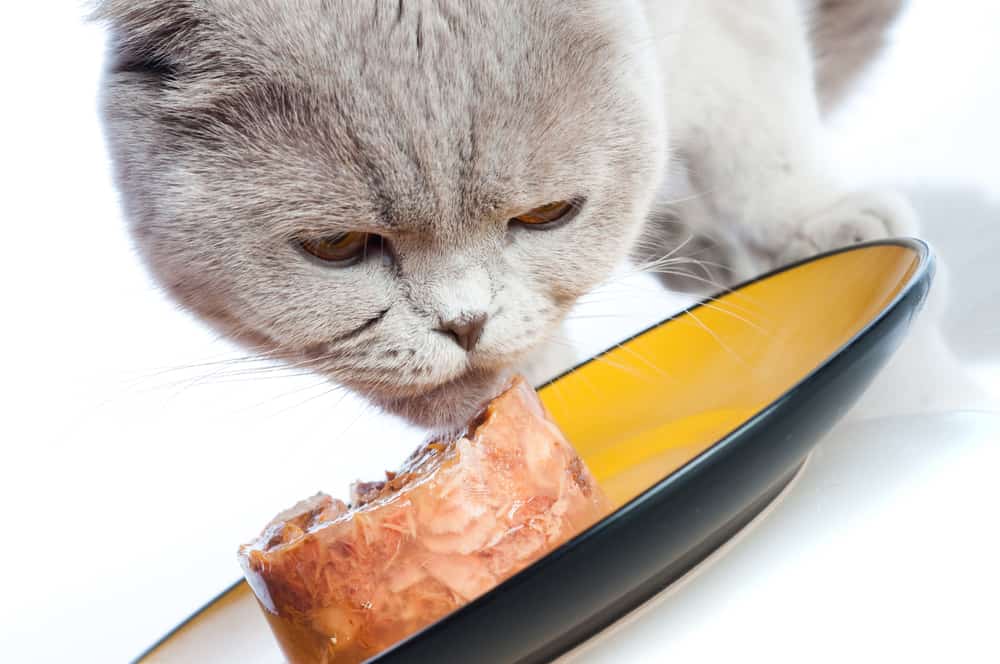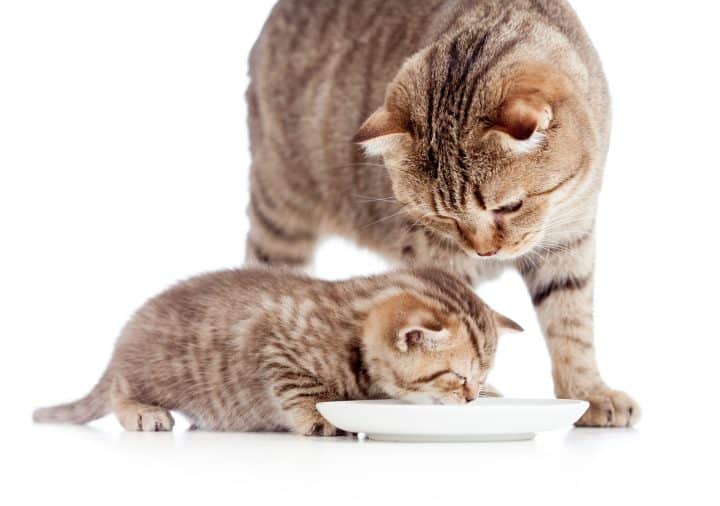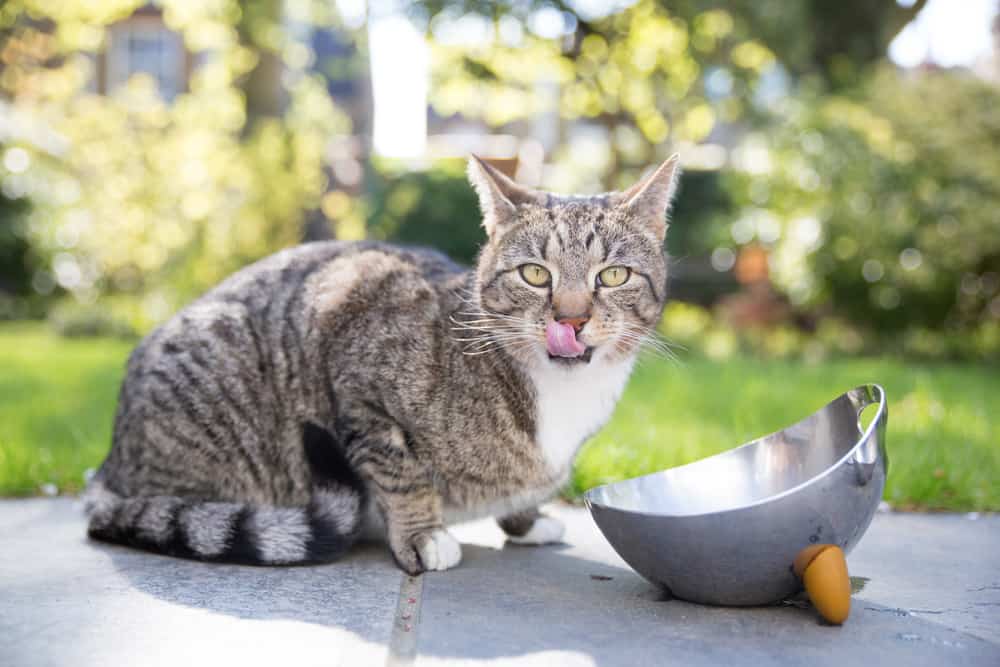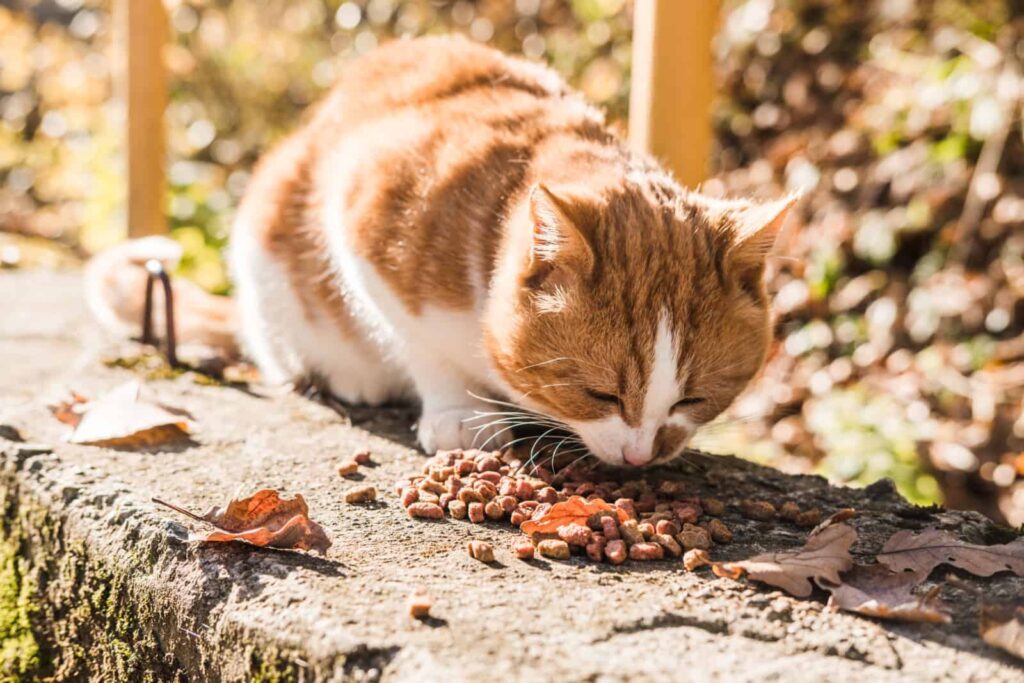In this post:
- What is Tapioca Starch, and Where Does It Come From?
- Why is Tapioca Starch Added to Some Cat Foods?
- Is Tapioca Starch Nutritious?
- Is it True That Tapioca Starch Contains the Toxin Cyanide?
- Then How Did Cassava Get a Toxic Reputation?
- Aren’t Grain-Free Diets Healthier?
- What About Food Allergies and Tapioca Starch?
- Closing Thoughts
in Food & Diet
Our cats give us comfort, companionship, and entertainment, so naturally we strive to feed them the highest quality diet to ensure a long and healthy life.
But how can you distinguish marketing claims from science-based nutrition? Tapioca starch is one of those mysterious ingredients that pops up on pet wellness forums, generating more questions than answers.
Why do pet food companies include tapioca starch in some cat foods? Is it safe? Is it nutritious for cats?
Tapioca starch serves as a binder and carbohydrate in some grain-free pet foods. Derived from cassava, highly processed tapioca starch contains neither poisonous hydrogen cyanide nor significant nutrients. It’s safe for healthy cats, but should be avoided in obese and diabetic cats. Cats with rare grain allergies may benefit from these diets.
It’s safe, but do grain-free cat foods containing tapioca starch provide any advantage over diets containing grains? Misinformation abounds on this topic so let’s break down some of the relevant considerations when deciding if tapioca starch-containing cat foods are appropriate for your cat. That way, you can rest easy knowing you’ve made an educated choice.
What is Tapioca Starch, and Where Does It Come From?
Tapioca starch is produced from the large roots of the cassava plant (Manihot esculenta). Cassava is also known by the names manioc and yuca (not to be confused with the ornamental yucca plant). Native to South America, this woody shrub feeds over 800 million people in South America, Africa, South Asia, and the Caribbean Islands. It holds third place behind rice and maize as a calorie source in these regions.
Cassava, with its hearty drought and pest-resistant nature and versatility, has sustained populations for centuries. Portuguese explorers introduced cassava to Africa in the 1600’s, and soon Southern Asia cultivated the crop. Currently, Nigeria holds first place for the largest cassava grower, while Thailand exports the most cassava-derived ingredients.
Why is Tapioca Starch Added to Some Cat Foods?
Tapioca flour is used in baking and for gravies and sauces for human consumption due to its thickening properties and bland flavor. For people with gluten intolerance or allergies, tapioca flour can bring cupcakes and cookies back to their plates. Due to consumer demand, many pet food companies produce grain-free products as well. Potatoes, peas, and tapioca starch often replace gluten-containing grains such as wheat, or gluten-free grains such as rice.
Pet foods derive calories, or energy, from protein, fats and carbohydrates. In addition to energy, pet foods must contain essential nutrients and ingredients that confer palatability – if your kitty turns up his nose, it won’t matter if the food is nutritious.
Further, commercial pet foods must stay fresh and contain ingredients that allow proper consistency. For example, we expect the best dry cat food to be uniform crunchy bites that don’t break apart into crumbs when the bags are transported or stored.
Tapioca starch serves as a binder to hold together multiple ingredients and create the proper texture. Its bland flavor and low cost make it an acceptable carbohydrate source that won’t taint the flavor. Cat food manufacturers use tapioca starch as both a replacement carbohydrate and ingredient binder for those pet owners seeking a grain-free alternative. More on this in a bit.
Is Tapioca Starch Nutritious?
Tapioca contains a small number of minerals such as iron, but overall does not have nutritional value compared to whole grains. It contains far less protein than rice or wheat.
However, things can get confusing when you consider that Cassava, which is where tapioca starch comes from, does contain many nutrients. But the intensive processing required to produce tapioca starch diminishes the nutritional value, so don’t confuse the two. Tapioca starch is primarily a binder and carbohydrate.
Is it True That Tapioca Starch Contains the Toxin Cyanide?
Nope!
Maybe you’ve read some pretty scary – okay terrifying – articles about cyanide poisonings in people. Let’s unpack the controversy and focus on facts because, as is often the case, misinformation stems from related facts.
True: Unprocessed or poorly processed cassava can kill.
Cassava plants produce bitter-tasting cyanogenic glycosides to ward off grazers and insects, just as thorns protect roses from hungry animals. These compounds occur in over 2000 plant species, and are relatively non-toxic. However, as the cassava plant is mashed when chewed or digested, enzymes convert the compounds to hydrogen cyanide. But before you dump your specialty cat food, keep reading.
How could a highly toxic plant be a staple food source for over 700 million people? The answer is two-fold. Two main varieties of cassava exist, sweet and bitter, and they are grown for different purposes. The roots of the sweet variety make a versatile food source, much like a potatoes, whereas the bitter type is used for industrial purposes. They both contain cyanogenic glycosides (linamarin and lotaustralin) that can be converted to toxic hydrogen cyanide when ingested.
However, bitter cassava has about ten to fifty times the hydrogen cyanide content as sweet cassava. As with most poisons, the danger is in the dose. Keep reading, because I’m not suggesting you or your cat eat small amounts of cyanide.
Sweet cassava, used to make tapioca powder, can be processed to make it safe for consumption. The toxin-concentrated skin is carefully removed. The native way of preparation involves washing, cutting, and drying in the sun days to allow the toxins to evaporate. Hydrogen cyanide is water-soluble (easily washed away with water) and volatile (breaks down). Industrial processing of sweet cassava to produce refined products involved well-established and consistent protocols.
The final product is perfectly safe and eaten in many forms worldwide every day without harm.
Read Also: Are Poinsettias Poisonous To Cats – Everything You Need To Know
Then How Did Cassava Get a Toxic Reputation?
Substitution of bitter varieties for sweet cassava, a malnourished population, and improper processing to remove toxins have all been implicated in tragic poisonings that resulted in rapid death. Chronic exposure to cyanide in minuscule amounts can lead to neurologic problems and thyroid gland disease (goiter).
In Africa there have been widespread incidences of human poisoning by poorly processed cassava. These populations are often malnourished and the very low protein level in the diet was thought to contribute to vulnerability to toxins.
A hunger crisis in Venezuela more recently led to deaths when people consumed the bitter form of cassava. In Uganda, children were poisoned by chips made with cassava flour from a wild form of the plant. There was even a cracker recall in Australia due to an unusually high level of cyanogenic glycosides from cassava. These cases involved cassava, not the further processed tapioca starch. There have been no cat or dog pet food recalls related to cyanide levels from tapioca starch.
Tapioca starch is not toxic, and unlike the melamine scandal with pet foods, manufacturers have no ulterior motive to sneak cyanide into cat food. (Melamine was added to boost the perceived protein content, causing illness and death.)
Aren’t Grain-Free Diets Healthier?
Grain-free diets.
What a marketing briar patch!
Here’s where marketing elbows science out of the way. Grains became demonized in the human diet over twenty years ago, and controversy quickly followed. The high protein, low carbohydrate diet fad helped many people lose weight, but the claim of improved cardiovascular health was hotly debated.
Next gluten became demonized as a pro-inflammatory ingredient causing gastrointestinal and other problems in some people. Those with true food allergies or intolerances such as celiac patients require the elimination of gluten from the diet. Many pet owners sought a similar diet for their pets and pet food companies jumped to capture that market.
Let me assure you, grains are not an enemy to healthy cats.
It’s true that cats are unique in that they are obligate carnivores. This means that the amino acid taurine, found in animal protein, is an essential part of their diet – they cannot make it from other proteins. Without it, they develop a thickened heart (hypertrophic cardiomyopathy) and can eventually die from heart disease.
But that does not mean grains are harmful!
In fact, they may be a healthier source of carbohydrates than those found in grain-free diets. Grain-free diets do not necessarily have fewer carbohydrates. Grains are an excellent source of fiber, vitamins, minerals, and essential fatty acids and are not just fillers in pet foods. Cats are able to digest and utilize these nutrients efficiently. Fiber contributes to proper intestinal function and healthy stool formation, helping the gut microbiome thrive. It helps hairballs pass. It can slow digestion and keep blood sugar from spiking. Fiber also helps cats poo.
But wait, feral cats don’t eat a bowl of rice with their mice, right? Lions don’t make oatmeal each morning on the savanna.
So you may wonder why your house kitty needs fiber. High-quality commercial diets are formulated to maximize nutrition for house cats. When wild felines ingest their prey, they also ingest the plant-based stomach contents. The fur, feathers and bones may also provide some of the benefits of fiber as they pass through the intestinal tract. House cats are more sedentary and therefore have different dietary needs.
Typical high-quality diets contain complex carbohydrates which slow down digestion and insulin release. Simple carbohydrates like sugar induce rapid release of insulin. Tapioca starch is a highly refined simple carbohydrate and readily digestible.
While there is currently no evidence that any commercial diet causes feline diabetes, diabetic cats or obese cats at risk for diabetes can benefit from eating a higher protein diet with a complex carbohydrate. Highly refined starches such tapioca starch can cause insulin spikes and weight gain, and thus are not ideal diets for these cats.
While we are discussing cats, let’s take a moment to mention dogs just in case your cat has a canine pal. Grain-free diets can be harmful to dogs. Dogs on grain-free diets have developed dilated cardiomyopathy, a severe heart disease. This is well-documented. So far cats have not been shown to develop similar problems, but I thought it was worth mentioning.
What About Food Allergies and Tapioca Starch?
Many cat owners worry their cat may have an allergy to grains, and seek a grain-free diet for this reason. Food allergies can cause itching, hair loss, and gastrointestinal upset in cats.
But the vast majority of true food allergies are to animal proteins such as chicken or fish, not grains. Allergies to grains are exceedingly rare in cats! Your veterinarian can help develop a plan to determine if your cat has food allergies, as a diagnosis is not straightforward. A food trial with a novel protein diet or hydrolyzed protein diet for eight to twelve weeks can help determine if your cat has a food allergy. There are other causes of these symptoms so switching to a grain-free diet is way down on the list of steps to take if your kitty’s fur is thinning. ‘
Closing Thoughts
That was a lot to unpack just to serve breakfast to your meowing friend!
The bottom line: high-quality commercial pet foods are formulated to provide balanced nutrition for most cats. A cat with a rare allergy to certain grains such as corn or wheat may benefit from a diet where those grains are replaced with tapioca starch.
The cyanide scare with tapioca starch isn’t a real issue assuming proper processing of the sweet cassava plant. Millions of people eat tapioca starch in various forms worldwide without illness. If you're not sure what to feed your cat, talk to your veterinarian to see if there are specific health concerns, such as being overweight, that might steer you toward a specific diet. A commercial cat diet containing high-quality protein sources with grains can allow your feline friend to thrive for years to come.
If you're interested in more deep dives into specific ingredients, then check out this article I wrote on montmorillonite clay in cat foods.
👉 Learn more about cats:





